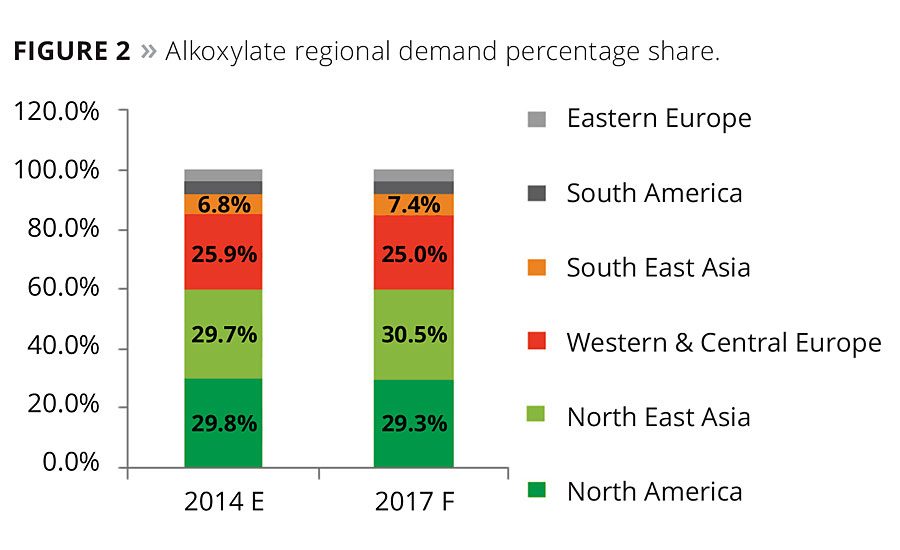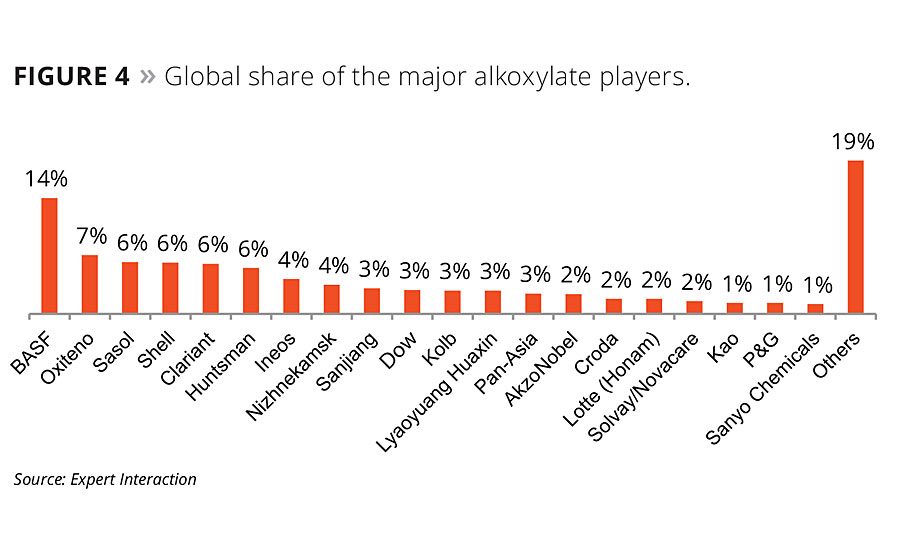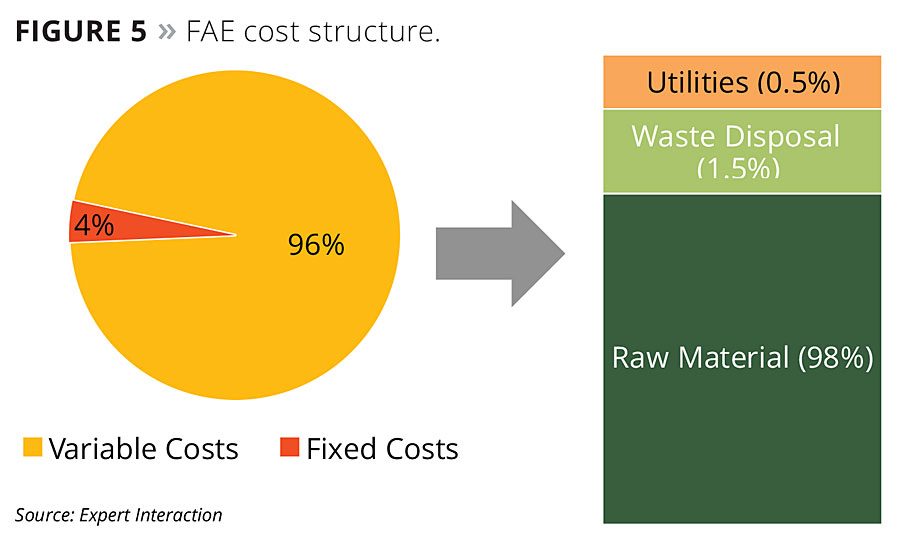Surfactants play a key role in the coatings industry. They are used as binder emulsifiers and as pigment dispersants; also, they are required to improve wetting on low-energy substrates to control foaming during application and to prevent film defects caused by surface tension gradients. The majority of waterborne paints are latex. The emulsifier used in latex preparation is normally a combination of non-ionic and anionic surfactants. Traditionally, alkyl phenol ethoxylates (APEs) have been the workforce of the coatings industry, but serious environmental concerns require the industry to move to lower-VOC and APE-free formulations.
With legislation in Europe and the green movement in the United States, Canada and other regions restricting the use of APE-based surfactants in coatings formulations, developing alternatives that can efficiently replace and impart a similar level of performance as APE has become increasingly urgent and much needed.
For the surfactant market, the trend seems to be on continuous innovation and broadening product categories. Future focus of coatings manufacturers should be on developing environmentally friendly formulations as well as developing products that support various formulations. Coatings manufacturers should focus on collaborating with surfactant suppliers and developing new formulations that support lower VOCs while still maintaining high performance standards.
Overview of the Alkoxylate Market
The global alkoxylate market is expected to grow at a CAGR of around 2-3% until 2017. Figure 1 shows the global alkoxylate supply versus demand. Mature markets such as North America and Western Europe are expected to witness a growth rate of around 1.5-2%. Growth is expected to be more prominent in developing regions like China and India, with an estimated growth rate of around 4.5%. Figure 2 shows the regional demand for alkoxylates. Alkoxylates account for around 85% of the nonionic surfactants market.
Global demand for alkyl phenol ethoxylates is expected to decrease at a CAGR of around 9.3% until 2017. In Western and Central Europe, the United States and Canada, industry trends seem to shift away from APE to lower-VOC and APE-free formulations.
Risk Associated with APE
APEs are a group of non-ionic surfactants that have been popular for more than 40 years due to their effectiveness, economy, and ease of handling and formulating. Nonylphenol ethoxylates (NPEs) represent the main product type in this group. Nonylphenol is produced and used in large quantities annually. Its toxicity to aquatic organisms and the fact that it is not readily biodegradable is a matter of concern.
As per the EPA, the use of products containing NPEs can result in the release of nonylphenol and other degradates to the environment, potentially exposing aquatic life to these compounds. The European Commission and the United States have already banned the usage of APEs in the personal care industry. As of now, limited usage is allowed in other industries like agrochemicals, coatings and textiles but is soon expected to get hit by a wave of strong environmental restrictions.
Fatty Alcohol Ethoxylates as Alternatives
Fatty alcohol ethoxylates (FAEs) are considered the best replacement for NPEs. The performance of these non-ionic surfactants can be adjusted by the alcohol selection and by the length of the hydrophilic polyethylene glycol chain. In comparison to NPEs, alcohol ethoxylates are usually more biodegradable and are not toxic to aquatic organisms.
In order to identify the right alternative for nonylphenol ethoxylates, the functions and properties of these products in varied applications need to be considered. NPEs have excellent emulsifying and dispersing properties, which enable the user to effectively formulate stable emulsions. Alcohol ethoxylates chosen in place of NPEs need to impart the same level of performance with similar ease of use.
The majority of mid-chain alcohol ethoxylates are better wetting agents or detergents in most applications. The difficult task for the replacement of NPEs with FAEs is to balance the good wetting and detergency properties with the emulsifying, dispersion and the other properties that are additionally needed in most applications.
Properties of fatty alcohol depend upon the chain length and the structure. Due to the diverse formulation and application requirements, only the formulator is able to select from among the diverse physical and performance properties of the FAEs to find the right alternative product for NPEs.
Moreover, prices of fatty alcohol ethoxylates are lower and less volatile compared to NPEs. The Q2 2014 Europe price for NPE was €2800-3100/MT whereas FAE (2 EO) prices for Q2 2014 averaged at €1370-1395/MT and FAE (7 EO) stood at €1425-1450/MT. Also, prices for FAEs in Asia and Europe are lower compared to NPEs prices.
Alcohol Ethoxylates: Supplier Base
Present global capacity for alcohol ethoxylates is around 5,600 thousand MT and is expected to reach 5,800 thousand MT by 2017. Enough capacity is available to cater to the demand for alcohol ethoxylates until 2017. Figure 3 shows the major global alkoxylate suppliers.
Nameplate capacities of the players represent the total ethoxylation capacity for alcohol ethoxylates, alkyl phenol ethoxylates and other speciality ethoxylates. As mentioned earlier, alcohol ethoxylates account for around 70% of the alkoxylates capacity, and the majority of the players mentioned in the figure supply alcohol ethoxylates.
Figure 4 highlights the global share for the major players in alkoxylates. Others include India Glycols, Stepan, Arak Petrochemical Co., Galaxy Surfactants, Venus Ethoxyethers, Nippon Shokubai, Mitsui, Optimal Chemicals etc.
Recommendations for Product Selection
The physical properties and performance of alcohol ethoxy-lates depend on three major factors: alkyl chain length, alkyl branching (structure) and polyethylene glycol chain length. Depending on these three factors, alcohol ethoxylates reveal some general trends in their properties.
Effect of Alkyl Chain Length
A longer alkyl chain results in a higher melting point of the ethoxylates and reduced wetting properties, provided the ethoxylation degree and branching of the alkyl chain are kept constant. Also, long chains are better emulsifiers and have less odor compared to short chains. Chain length C12 to C13 show maximum foaming properties compared to short- and long-chain products.
Effect of Alkyl Chain Structure
Branching results in a lower melting point of the ethoxylates and improved wetting properties, provided ethoxylation degree and alkyl chain branching are kept constant. Products with branched chains foam less compared to straight chain products under standard conditions. Linear chained products show lower critical micelle concentrations and higher emulsifying efficiencies, but if the formulations are not adjusted properly, linear products produce undesired gel phases. Biodegradation becomes slow as the number of branches increase.
Effect of Polyoxyethylene Chain Length
The length of the polyoxyethylene chain decides the performance characteristics of alcohol ethoxylates. At low ethoxylation degrees the alcohol ethoxylates are oil-soluble. As the ethoxylation range moves from low to medium, products possess the highest surface activity and best wetting performance. Therefore, these products are multipurpose surfactants for a wide range of applications. An even higher degree of ethoxylation will further increase the water solubility. Highly ethoxylated products have good dispersing properties and are oil-in-water emulsifiers for hydrophilic oils.
FAE Cost Structure
Fatty alcohol ethoxylates are obtained by treating fatty alcohol with ethylene oxide and potassium hydroxide, which acts as a catalyst. Pressure is created in the reactor with nitrogen and is heated at around 150 °C. The amount of ethylene oxide and the reaction time determine the degree of ethoxylation, which in turn determines the surfactant properties of the ethoxylated product.
The raw material accounts for 98% of the FAE manufacturing cost, i.e., mainly the type of fatty alcohol used (Figure 5). Considering the fact that ethylene oxide is dangerous and perishable, fatty alcohols after ethoxylation can’t be stored for long and are to be used quickly.
Opportunity for Saving
The market structure for the FAE industry is “oligopolistic,” as those few companies operating in the market have complete control over the price of the product. Moreover, FAEs produced by various companies don’t differ much in terms of performance and quality. Therefore, the prices of the FAEs offered by various companies in a particular region would be interdependent upon each other. Companies offering a lower price will enjoy the greater market share, forcing other companies to lower the price as well.
There are two main routes to procure FAEs – direct purchase or inviting bids. Direct purchase obviously leaves very little or no room for negotiation. The bidding process usually results in lower prices, but is even more effective with a pre-bidding strategy. Efficient procurement is all about having a deep understanding about all levels of the supply chain. A pre-bidding strategy is to have proper knowledge about the feedstock market of the product and to arrive at a tentative price of the product. This will put the buyer in a better position to negotiate with suppliers.
The effectiveness of the pre-bidding strategy depends on having insight into the direction of both pricing and supply situations. Since 98% of the FAE cost is attributed to raw material, it is important for the buyer to keep track of the feedstock market, i.e., fatty alcohol. It is worth noting that companies benefit most out of this strategy if the procurement team works in close integration with the forecasting team.
For a long time, companies have used certain tools for procuring FAEs, including price caps, adjustable prices and the practice of mixing contracts with spot purchases. With solid insight about the direction of prices, supply and demand, the pre-bidding strategy can be used along with the same tools to achieve an advantage over the competitors. Using this strategy, a buyer will be able to lock prices lower as compared to other competitors giving him an opportunity to reduce final product, achieve higher profitability and expand market share.
Collaboration is the Key to Better Negotiation
Owing to limited exposure of the buyer to the FAE market and the need for customized formulation, suppliers charge high prices. One way to tackle this situation is to work in collaboration with the manufacturer and provide capital to secure long-term contracts with favorable pricing, or create contractual obligations to offer incentives for the suppliers to increase capacity.
An integrated approach works well under most of the market conditions and helps companies to capture an incremental advantage over many of its competitors.
Conclusion
With stringent regulations in Europe and the green movement in the United States, Canada and other regions, introducing an alternative to APE in coatings formulations has become highly important. Fatty alcohol ethoxylates (FAEs) have been considered as the best replacement for nonylphenol ethoxylates. Some suppliers have already developed products which are APE free and are excellent wetting and dispersing agents. Owing to the buyer’s limited exposure to the FAE market and the need for customized formulations, suppliers charge high prices. One way to tackle this situation is to work in collaboration with the manufacturer and provide capital to secure long-term contracts. Another way is to learn the intricacies of the FAE market and gain an understanding of the raw material market, industry happenings and price trends. Applying these insights to the current procurement practices prevailing in the FAEs industry give an advantage in terms of procuring the raw material and offering the final product at a competitive price.
References
1. http://www.sasoltechdata.com/MarketingBrochures/Alcohol_Ethoxylates.pdf
2. http://msdssearch.dow.com/PublishedLiteratureDOWCOM/dh_07f3/0901b803807f336c.pdf?filepath=productsafety/pdfs/noreg/233-00257.pdf&fromPage=GetDoc
3. http://www.elementisspecialties.com/esweb/webprodliterature.nsf/allbydocid/8A624F4B7577972585257A01005B02FD/$FILE/Elementis%20Specialties%20-
4. http://www.pcimag.com/ext/resources/VirtualBrochure/Solvay.pdf
5. http://www.tego.de/sites/dc/Downloadcenter/Evonik/Product/Tego/en/Technical-Papers-Additives/PPCJ-APE-alternatives-for-universal-pigment-concentrates.pdf
6 http://www.sdn.sap.com/irj/scn/go/portal/prtroot/docs/library/uuid/d081ca74-2f2e-2f10-dbac cdc1df8d4dea?QuickLink=index&overridelayout=true&53575422051513













